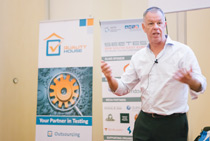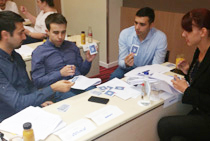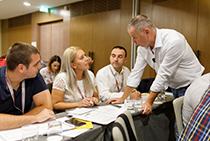Tutorials

Erik is a regular tutorial speaker both at national and international testing conferences, including leading international conferences such as EuroSTAR, STAR, Better Software and Agile Development. He holds the EuroSTAR record, winning the best tutorial award three times!
Erik has recently presented the following tutorials:
 LEAN USABILITY TESTING
LEAN USABILITY TESTING
It is curious that, while at least 40 percent of developed software code is directly or indirectly related to the user-interface, we still only dedicate a small percentage of our test effort to usability testing. Unfortunately, those testing for usability often lack the knowledge, skill, or time for this type of testing. In the agile era, everything needs to be result-focused, low on documentation, and highly efficient, which minimizes the focus on usability testing even more. To address this problem, this hands-on tutorial that introduces you to a number of easy-to-use, easy-to-learn lean usability test techniques. Explore techniques and practice heuristic evaluation, cognitive walkthroughs, and questionnaires. Each usability heuristic is discussed in detail, and checklists are shared and applied in exercises. Experiences are shared using these techniques in various projects and for many different types of software products. After this tutorial, start performing lean usability testing on your product.
“I was interested in learning new things about usability testing. This tutorial exceeded my expectations by far, tutorial with a lots of examples.”
 TEST PROCESS IMPROVEMENT – ALSO IN THE AGILE ERA!
TEST PROCESS IMPROVEMENT – ALSO IN THE AGILE ERA!
The Test Maturity Model integration (TMMi), developed by the TMMi Foundation, has a rapidly growing uptake and is now the de-facto world-wide standard for test process improvement. It’s growing popularity is based upon it being the only independent test process improvement model, and the simple presentation of maturity levels that it provides. The mistaken belief is that the TMMi and Agile approaches are at odds. Agile approaches and TMMi can not only coexist, but successfully integrate to bring substantial benefits to both Agile and traditional development and testing organizations. This tutorial will show with examples that TMMi and Agile methods can effectively work together. The challenge is to apply lean principles and practices to empower Agile practices and facilitate TMMi practices. Whatever you do a key to success is always to have the business needs and objectives drive the improvement process. Erik has much practical experience in implementing the TMMi model, in both traditional and Agile environments, and assisting organizations improve the way they test. Many practical experiences and results achieved are presented.
Winner best presentation award during the World Congress for Software Quality 2017, Lima (Peru).
 PRACTICAL RISK-BASED TESTING (PRISMA)– winner EuroSTAR best-tutorial award
PRACTICAL RISK-BASED TESTING (PRISMA)– winner EuroSTAR best-tutorial award
Although most projects implicitly use some kind of risk-based approach for prioritizing testing activities, critical testing decisions should be based on a thorough product risk assessment process with key business drivers as the foundation. PRISMA (PRoduct RISk MAnagement), a practical method for performing systematic product risk assessments is presented. It is explained how to carry out risk identification and analyzes, and how to use the outcome to select the best test approach. Learn how to use PRISMA in both traditional and agile projects, including creating an agile sprint test plan. Practical experiences are shared, problems overcome and results observed employing product risk assessments. Learn how to optimize your test effort by including product risk assessment in your testing practices. Develop a rigorous approach to inform project stakeholders about important testing decisions and provide clear visibility on product risk status.
“Tutorial on Practical Risk-Based Testing, it was awesome!”
“Great stuff! Passionate and knowledgeable speaker, keen to use this in my projects.”
 IMPROVING THE TESTING PROCESS
IMPROVING THE TESTING PROCESS
Whether you are working in a more traditional V-model environment or in an agile type environment, effective and efficient testing is always of importance. Improving the testing process does not necessarily imply using a model based approach such as TMMi or TPI-Next. This tutorial which is based on the ISTQB Expert level syllabus “Improving the Testing Process”, provides an overview of various approaches for test improvement. It combines the theory as documented in the ISTQB syllabus with many years of practical experiences in various domains by the tutor. The tutorial starts with an introduction to the fundamental issues concerning test process improvement. Basic questions like “why improve testing?” and “what can be improved?” are considered and the different ways that stakeholder can view quality are described. There are a number of different approaches which can be applied to test process improvement; overviews of these approaches are provided. The tutorial concludes with a detailed consideration of critical success factors and the test improvement manifesto. This is your chance to learn all about improving the testing process and the latest insights.
 Requirements Engineering for Testers
Requirements Engineering for Testers
Testers use requirements as the basis of test cases, review them for testability, and often participate in general requirements reviews or inspections. Unfortunately, many testers have little knowledge or skills in requirements engineering. What level of quality and detail is realistic to expect in requirements documents? What does testability really mean? How can testers help improve requirements? These questions and more will be answered while helping the attendee to develop skills in requirements engineering. Requirements issues and solutions are illustrated with practical case studies, and hands-on classroom exercises in finding, specifying and evaluating requirements are conducted. Walk through the requirements process from a tester’s viewpoint to learn what you can should contribute to requirements quality. At the end attendees will collaboratively create a set of “Golden rules” that every tester needs to successfully participate in the requirements engineering process.
“Thank you for an amazing workshop. I enjoyed it a lot and learned many things that we should work on and start improving.”
 Workshop Agile Tester – A PRACTICAL PERSPECTIVE
Workshop Agile Tester – A PRACTICAL PERSPECTIVE
Agile software practices are being employed within many development organizations worldwide. Agile does not automatically mean that product quality will improve. Many testers struggle to understand the Agile development process and their place in it. We will together identify some risks for software quality and key challenges occurring when implementing testing in an Agile context. You will learn the role of testing in the Agile team, and some key Agile testing practices. A number of down-to-earth testing practices that have shown to (also) work in an Agile context, e.g., risk-poker and exploratory testing, are presented and practiced in exercises. Discussion will take place on what day-to-day Agile testing often looks like, practice and theory could well be “somewhat” different.

